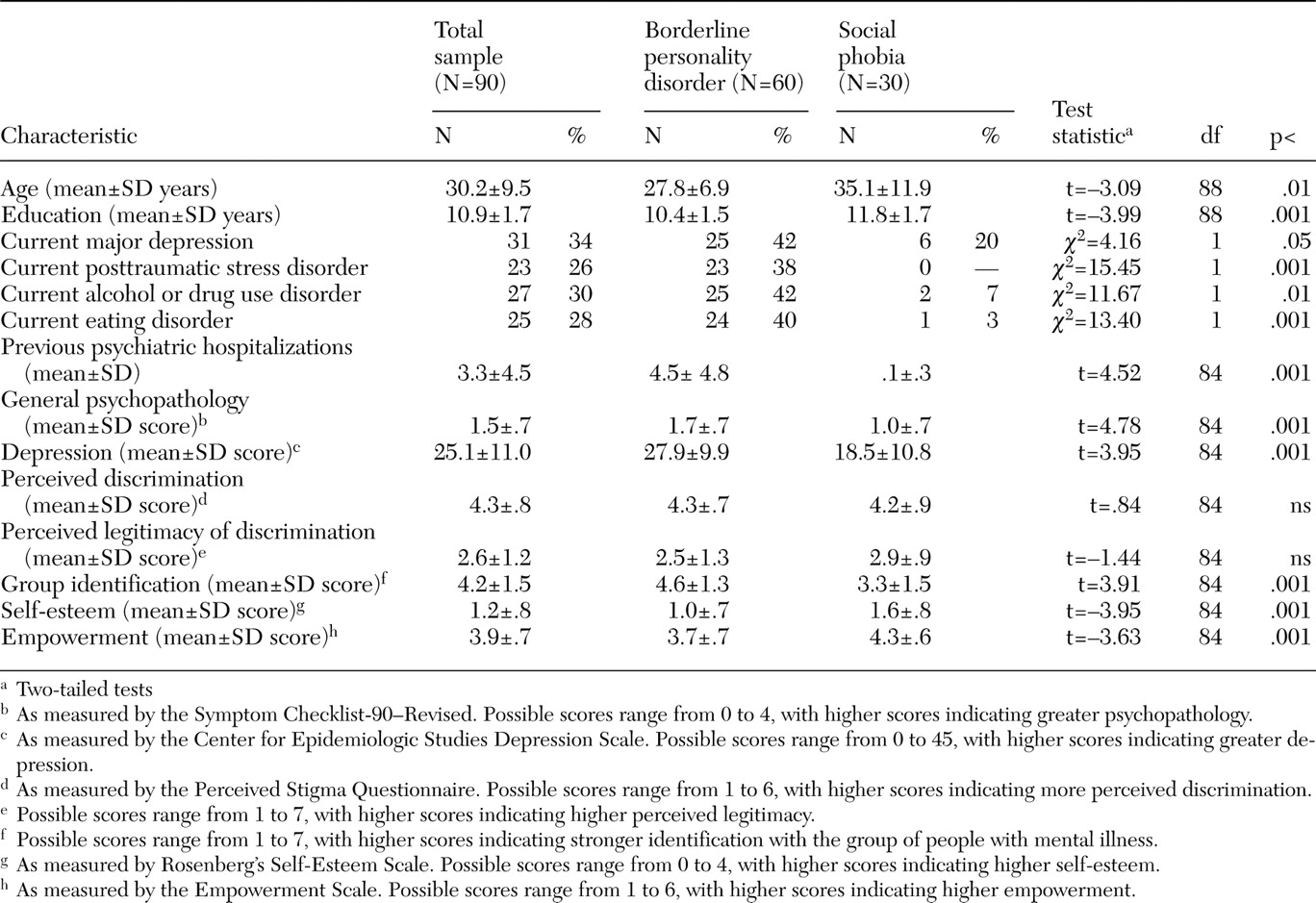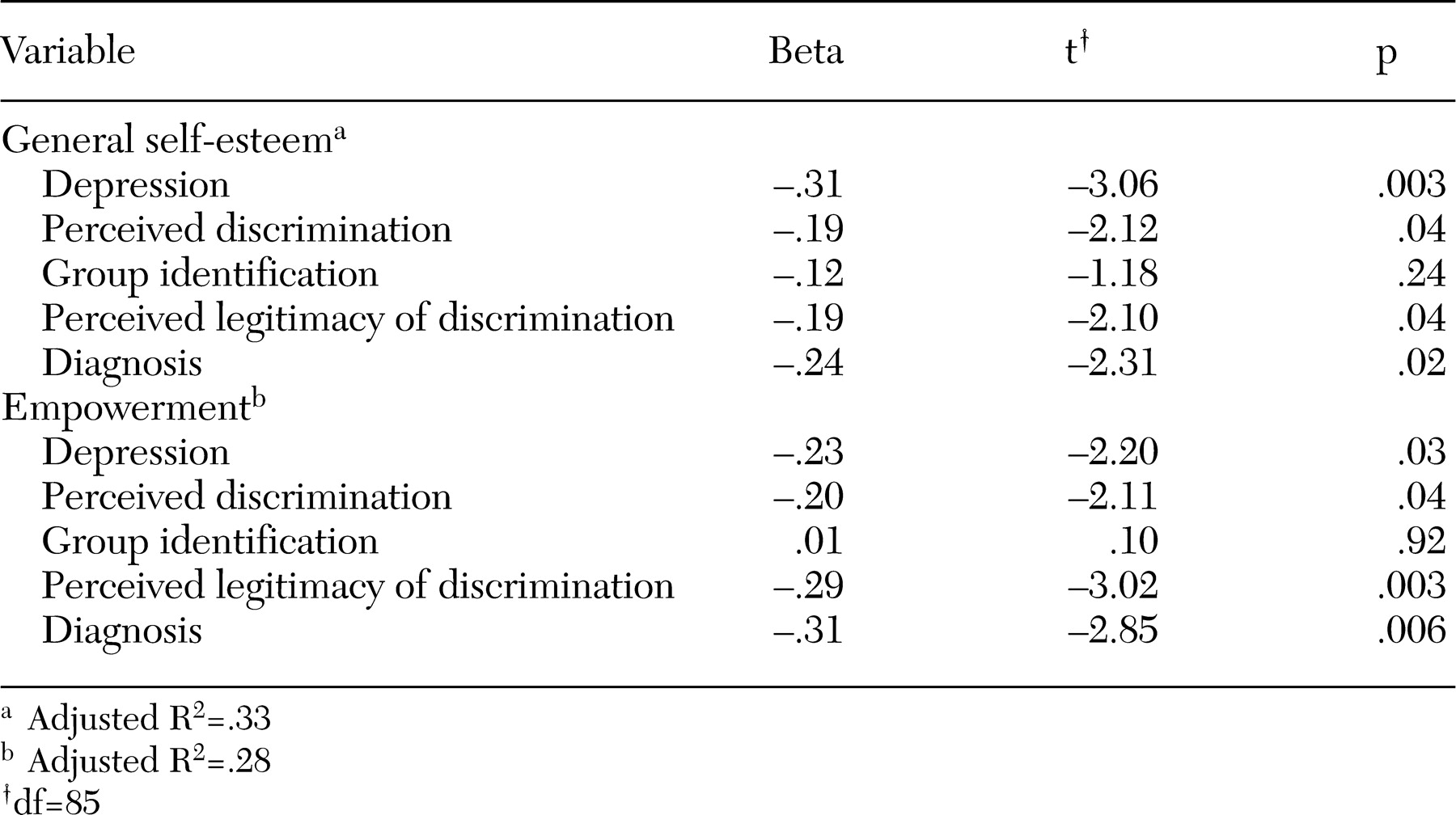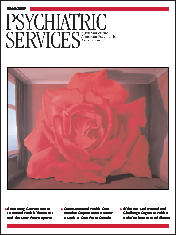People with mental illness often face a double problem: symptoms of their mental illness and public stigma (
1). Some people with mental illness accept the common prejudices and lose self-esteem, resulting in self-stigmatization (
2) (hereafter referred to as self-stigma). The fact that some develop low self-esteem while others remain indifferent to stigma or react with empowerment and righteous anger has been called the "paradox of self-stigma and mental illness" (
3).
Corrigan and colleagues (
3) recently hypothesized that two variables influence the personal response to public stigma: perceived legitimacy of discrimination and group identification (
3). If people with mental illness perceive discrimination as legitimate, they are likely to have low self-esteem. If, however, they regard discrimination as unfair, their reaction to perceived discrimination will depend on the level of identification with the group of people with mental illness. If they do not identify with this group, they are likely to remain indifferent, because they do not believe that public stigma refers to them. If, however, they show a strong sense of group identification, they are likely to react with empowerment and righteous anger. The study reported here was designed to empirically test this model of personal response to stigma associated with mental illness.
Among people with mental illness, two further issues need to be taken into account. First, in addition to self-stigma, depression is also likely to affect self-esteem and empowerment. Second, people with different mental disorders may react differently to public stigma. Women with borderline personality disorder are particularly likely to frequently experience public stigma and discrimination, because their disorder usually begins in early adulthood, has a chronic course, and often leads to multiple labeling processes, such as repeated psychiatric hospitalizations and visible scars. Women with social phobia are a particularly relevant comparison group, because public stigma is likely to be less intense than for women with borderline personality disorder, but fears of being humiliated and devalued constitute a core characteristic of social phobia as specified by DSM-IV criteria. These fears are likely to render individuals with social phobia vulnerable to self-stigma.
Methods
Sixty women with borderline personality disorder were recruited at the department of psychiatry and psychotherapy of the University of Freiburg in Germany and at the Psychiatric Hospital, Meissenberg, Zug, Switzerland. All 60 women met DSM-IV diagnostic criteria for borderline personality disorder as assessed by the appropriate segment of the Structured Clinical Interview for DSM-IV Personality Disorders. Thirty women with social phobia were recruited at the department of psychiatry and psychotherapy of the University of Freiburg and at the department of neuropsychology of the Central Institute of Mental Health in Mannheim, Germany. All participants with social phobia met diagnostic criteria for social phobia according to the Structured Clinical Interview for DSM-IV.
All participants were women between 18 and 50 years of age. They gave written informed consent after receiving a complete description of the study. Participants were recruited between the fall of 2003 and the fall of 2004. The study protocol was approved by the local ethics committee of the University of Freiburg. Sociodemographic and clinical characteristics are listed in the table.
Perceived discrimination means that a stigmatized individual is aware of public prejudices and discrimination against him or her. Perceived discrimination was assessed by Link's Perceived Stigma Questionnaire (
4). Low self-esteem as a consequence of self-stigma (
2) was measured by Rosenberg's Self-Esteem Scale (
5). Empowerment can be conceptualized as the opposite of self-stigma; it implies self-worth, self-efficacy, and the optimism to exert control over one's life (
6). Empowerment was measured by using the Empowerment Scale (
6).
Group identification is relevant to coping with perceived discrimination among members of stigmatized minority groups (
7). Identification with the group of people with mental illness was measured by using five items adapted from the work of Jetten and colleagues (
7). For example, one item states, "I feel strong ties with the group of people with mental illness." Cronbach's alpha for this measure was .79. Perceived legitimacy can be defined as an individual's subjective perception that the social hierarchy is fair and based on the different abilities or efforts of different groups. It was assessed with three items adapted from the work of Schmader and colleagues (
8). For example, one item asks, "Do you think it is justified that people without a mental disorder have a higher status than people with a mental disorder?" Cronbach's alpha for this measure was .66. Depression was measured by the Center for Epidemiologic Studies Depression Scale (
9).
Results
As shown in
Table 1, some similarities and differences were noted when women who had borderline personality disorder were compared with women who had social phobia. Levels of perceived discrimination and perceived legitimacy of discrimination did not differ between groups, whereas identification with the group of people with mental illness was stronger among women with borderline personality disorder.
To test the model of personal response to stigma among all 90 participants, we calculated two multiple linear regressions with self-esteem and empowerment as respective dependent variables and with perceived discrimination, perceived legitimacy of discrimination, and group identification as independent variables (
Table 2). To control for depression and index diagnosis, both were included as independent variables in the two regressions.
After level of depression and index diagnosis were controlled for, low perceived discrimination and low perceived legitimacy of discrimination predicted high self-esteem and empowerment. The level of group identification did not significantly predict self-esteem or empowerment (
Table 2). We were also interested in examining whether interaction terms of the independent variables explained additional variance in self-esteem or empowerment. Therefore, we calculated three product terms following a z-standardization, because scaling differed between the respective variables: perceived discrimination by perceived legitimacy, perceived discrimination by group identification, and perceived legitimacy by group identification. When each of the three variables was included as an additional independent variable in the regressions on self-esteem and empowerment, none of the interaction terms significantly predicted self-esteem or empowerment, nor did the adjusted R
2 of the regressions increase by more than .01 compared with the regressions reported in
Table 2. (This approach to hierarchical testing of interaction terms in multiple regressions has been described elsewhere [10].)
Discussion
Both depression and perceived discrimination seem to render individuals with mental illness vulnerable to low self-esteem and low empowerment—that is, to self-stigma. Our results suggest that low perceived legitimacy of discrimination may protect the self-esteem of people with mental illness and encourage them to feel more empowered.
These results in part confirm the model of Corrigan and colleagues (
3). As hypothesized, low perceived discrimination and low perceived legitimacy of discrimination appear to be protective against self-stigma. However, the hypothesis that group identification is related to high self-esteem and empowerment was not borne out in our study. Unfortunately, this negative finding indicates that there may be no protective in-group bias among people with mental illness as it exists in other stigmatized minority groups (
11). We could also not confirm the hypothesis of Corrigan and coworkers (
3) of an interaction between perceived legitimacy of discrimination and group identification. Our finding of nearly identical patterns in the regression analyses for self-esteem and empowerment is plausible given that empowerment and low self-esteem resulting from self-stigma can be seen as opposite poles on a continuum.
Perceived discrimination did not differ between the two diagnostic groups, probably because women with borderline personality disorder and women with social phobia are equally familiar with public stereotypes. However, although the groups were similar in the level of perceived legitimacy of discrimination, group identification was stronger among women with borderline personality disorder. This finding draws attention to the fact that individuals with different disorders may differ on variables that are relevant to the process of self-stigma. This difference corresponds well to the finding that public stigma differs for different disorders (
12,
13), which may in turn contribute to different processes of self-stigma. However, borderline personality disorder and social phobia are less well known mental illnesses; therefore public stereotypes that may affect self-stigma processes are less clear.
This preliminary study has several limitations. First, cross-sectional analyses limit conclusions with regard to causality—that is, we cannot exclude the possibility that low self-esteem may lead to increased self-stigma. Larger samples adequate for structural equation modeling and longitudinal studies are necessary to better understand interactions and causality. Longitudinal studies in therapeutic settings may inform us whether perceived legitimacy of discrimination—and as a consequence self-stigma—decreases as a result of certain interventions, for example, during cognitive-behavioral therapy that focuses on self-stigma or during successful pharmacologic treatment of depression. Second, our findings need to be replicated among individuals with other mental illnesses, such as schizophrenia and depression, to further examine possible differences between individuals with different disorders. Nevertheless, this study compared a group of women with borderline personality disorder, who are likely to be heavily stigmatized, and women with social phobia, who are less likely to encounter stigmatization. Finally, high rates of comorbid disorders among women with borderline personality disorder may have confounded the findings. On the other hand, comorbid disorders are a clinical reality in borderline personality disorder. Because all the participants in our study were women, our sample is more homogeneous, but possible gender differences in the reaction to public stigma remain unclear and should be studied in future investigations. Future research should use a comprehensive assessment of self-stigma and its components, including coping orientations and emotional reactions (
14).
Conclusions
To reduce self-stigma and increase a sense of empowerment among people with mental illness, we need to better understand why individuals react differently to public stigma. This study provides initial empirical evidence that perceived discrimination and perceived legitimacy of discrimination have an impact on the personal response to public stigma and that individuals with different disorders may react differently. A better understanding of the factors that protect against self-stigma may enable us to help individuals with mental illness avoid the loss of self-esteem and empowerment that results from self-stigma.
Acknowledgments
The authors are grateful to Manfred Olschewski, M.Sc., for advice on statistical procedures. They also thank Ines Göttler, Christiane Hermann, Ph.D., Aurelia Hölzer, Sabine Kech, Dipl.-Psych., Thomas Kühler, Ph.D., Florian Leihener, Dipl.-Psych., Julia Ofer, Dipl.-Psych., Sarah Schiel, and Elisabeth Schramm, Ph.D., for help with data acquisition.



